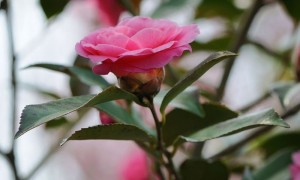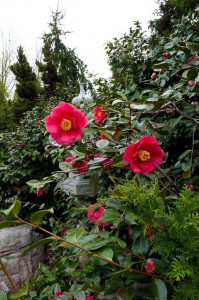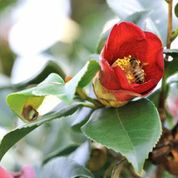Camellias, the "Winter Rose," Offer Color & Charm
by Lynn Kirk, Public Relations Writer, Lewis Ginter Botanical Garden, reprinted with permission from the Richmond Times-Dispatch

Camellias speak the language of love. A pink bloom symbolizes longing, white suggests adoration and red embodies a flame in one’s heart. Photo by Don Williamson
If you think winter’s garden can’t sprout flowers, think again. In our Zone 7, several cold-hardy ornamentals perk up cold-weather landscapes with bursts of floral color. Winter jasmine and witch hazel are two striking examples, but perhaps the south’s most well-known, well-loved winter bloomer is the camellia, sometimes referred to as “the winter rose.”
“A great many camellias bloom in winter or when you least expect them, depending on the hybrid or species,” said Brian O’Neil, director of horticulture at Norfolk Botanical Garden. “They provide color at a time when we need it most.”
O’Neil speaks from experience, working with his staff to nurture one of the largest camellia collections in the southeastern U.S. The 75-year-old botanical garden is home to more 1,700 camellia plants and more than 1,200 different camellia types, which have earned prestigious designations as an Official North American Collection and a Garden of Excellence.
“Camellias are part of this garden’s history and the history of Norfolk,” said O’Neill. “Frederic Heutte, the [Norfolk] Botanical Garden’s first director, was one of the first to grow camellias outdoors in this area.” Staff continues expanding the collection through the addition of species camellias, dwarf and groundcover forms, as well as ancient varieties cultivated before 1900.
The ancient strains are hardier and worthy of preservation, yet today’s hybridized varieties flaunt flashier and brighter blooms with sizes varying from shrubs to trees. Each bloom is lovely, seemingly eager for a second glance, whether single or double-blossomed, peony or rose-shaped, brilliant fuchsia or cotton-candy pink. Creamy white cultivars also sport wintry appeal and intriguing names like ‘Frost Princess,’ ‘Snow Flurry’, ‘Polar Ice’ and ‘Winter’s Hope.’ Most camellia blooms boast a bright-yellow cluster of stamens that are quite striking amid the plant’s glossy evergreen leaves.

Caption – The camellia originated in Asia, represented by this ornamental stone lantern in the Asian Valley at Lewis Ginter Botanical Garden. Photo by Don Williamson
Some camellias postpone their floral show until spring, so O’Neil suggests knowing each variety’s blooming schedule prior to planting. He also hints at expanded offerings, such as the Camellia azalea that blooms during summer and bright-yellow tropical camellias, C. nitidissima and others, that are being used in breeding to develop more cold-hardy yellow camellias.
In addition to beauty, camellias are appreciated for their tolerance to shady areas, even beneath trees. They must be well watered the first couple years following planting, but typically become more drought-tolerant once established. O’Neil said a tap root formed by seedlings is perhaps an adaptation to obtain water from deeper soil levels.
Locally at Lewis Ginter Botanical Garden, gardeners and homeowners can see a variety of camellias in their splendor and browse the Lora M. Robins Library for related information. Two notable online resources are the American Camellia Society and the Virginia Camellia Society.
Editor’s Note: This article first published in the Richmond Times-Dispatch, on March 10, 2013
